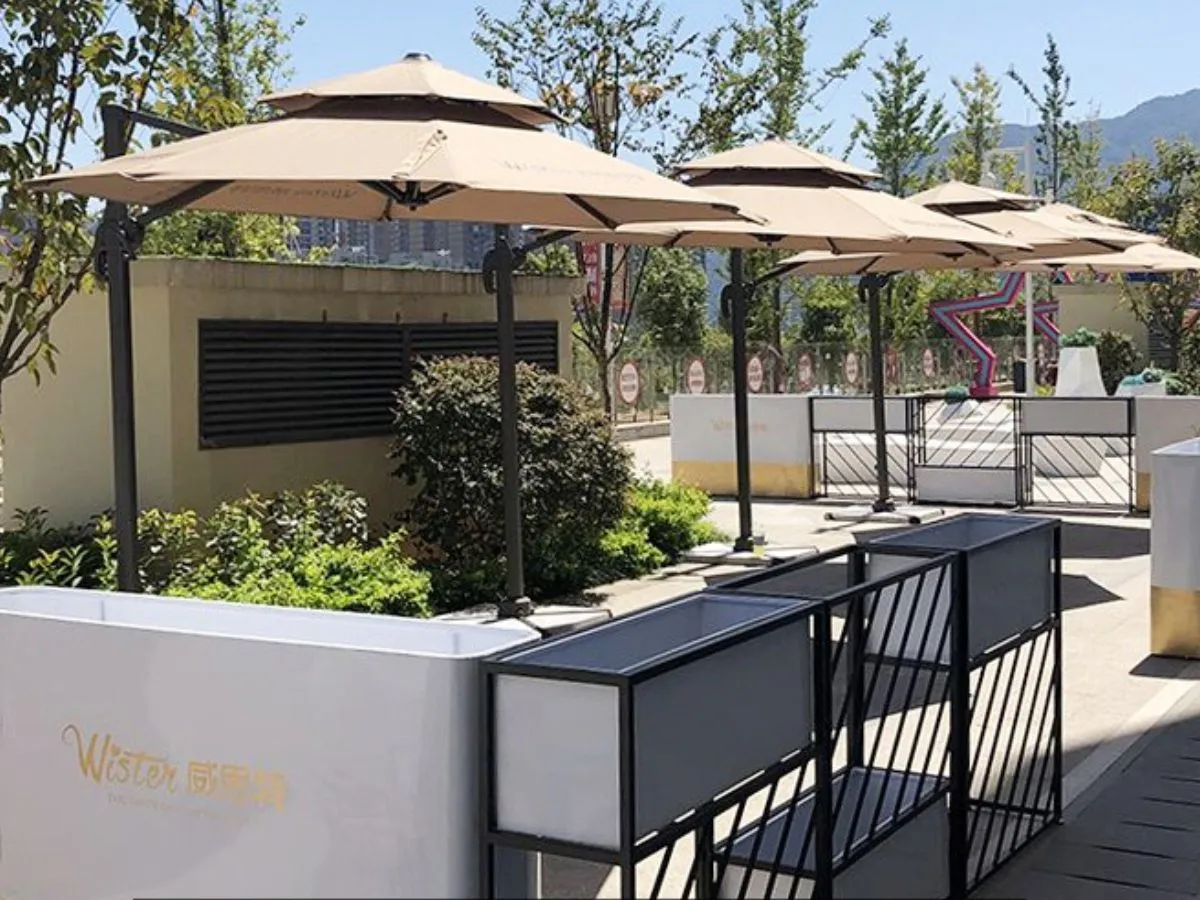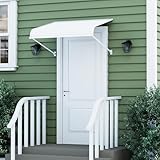10 Best Awnings and Buying Guide

Table of Contents
Editor Pick Awnings
Awnings Buying Guide
Awnings offer protection and shade to your windows, patio, and doors. The primary purpose of an awning is to function as a canopy, produce a break from strong wind, and provide protection from the rain, sun, and snow.
Awnings can also ensure the home’s interior remains cool by blocking UV rays from shining through the glass doors and windows. However, choosing an awning is not a straightforward process. There are several types, sizes, materials, and shapes to choose from.
This can make the entire buying process overwhelming. But do not worry! This is the only guide you need to choose the right awning for your outdoor space.
Why You Should Invest in Awnings?
You will enjoy several benefits when you invest in awnings. Here are some of them.
They Reduce Your Energy Costs
If you strategically install an awning, you will save money and decrease your carbon footprint. Awnings are also known as the “original air conditioner.” They can reduce your energy costs by 25%. And during winter, you can retract your awning to benefit from the extra light and warmth the sun provides.
Protection From Weather Conditions
Installing an awning over the area, you intend to cover will offer beneficial shade and protect you and your loved ones from up to 98% of harmful UV rays from the sun. You can decrease the temperature of your outdoor area by up to 25°F when you use a retractable awning to reduce direct sunlight. Doing this will enhance your outdoor experience and protect your loved ones’ health.
Factors to Consider Before Choosing Your Awning
Before you shop for your awning, you must consider some crucial factors. Considering these factors will ensure you pick the right awning for your home. Here are some of them.
Decide on the Type of Awning You Want
When choosing your awning, the first thing to do is to determine the type you want. Many manufacturers categorize various awning types the same way. However, they are different since they offer other functionalities. Here are the common awning types most homeowners prefer.
Patio Awnings: this is the most popular awning type. When people think of awning, a patio style is what they picture. Patio awnings are fastened to a wall. And they spread outwards over a smoking or seating area.
Conservatory Awnings are usually fastened to an existing roof construction with their unique framework. Conservatory awnings with exterior designs provide shades from over the glass, while those with internal designs provide shades from under the glass. These awnings also can withstand weather conditions. Conservatory awnings will easily block sun rays before they reach the glass, providing enhanced temperature control.
Pergola Awnings: Pergola awnings are also fixed to the wall like their patio counterparts. However, they come with fixed frame patterns that remain rigid when retracting them. Pergola awnings also get added stability from the extra front support posts
Side Awnings: they are also known as garden-side awnings. They usually run across your balcony or garden to create a primary barrier for your outdoor wall. Side awnings generally come with large screens as an effective and elegant way to handle a low-lying sun and constant wind. They are also ideal for providing privacy from passersby and neighbors. The frame of a side awning must be installed using a sturdy pole or a solid wall that is 10ck thick. Side awnings are also the most accessible awning type to install. It only takes a few minutes to install them. Numerous side awnings come with manual retractability. They use sturdy retractable springs that offer great versatility for long-lasting and smooth operation.
Choose the Right Size for Your Awning
The size of your awning will determine its functionality. The primary purpose of an awning is to serve as protection from the sun. So, to ensure optimal and efficient performance, you must determine a suitable size for your awning. The area you want to cover should be the primary factor you use in choosing the size of your awning.
Some essential rules also apply to your awning’s measurement. The size of the awning you choose must be wider than any doors or windows. It must also be larger than the area you want to cover. The standard measurement for an awning’s width is usually three meters.
You must also never forget the sun constantly moves. This means that the sun’s position will change during the day. So, it’s essential that you examine the sun exposure level and also assess the shade the area you want to cover requires. Numerous free shadow plotting apps online would help you out with this process.
It would be best if you also decided on the optimal length of your awning’s arms after being folded. The technical term for this measurement is called arm projection. Numerous awnings usually have an arm projection between 1.5 to 4 meters. Although you will indeed find awnings that can cover vast areas, the most popular arm projection is usually around 3.5 meters.
Other measurements to consider before choosing the right size for your awning include:
- Your lintel’s height
- The awning’s height
- The distance between the roof and the doors or windows
- The type of area you intend to cover with your awning
- The general width of your awning, including cassette and motor
Choose the Material That Would Suit Your Needs
The material of your awning is the next factor to consider after you have decided on its size. The quality and properties of the material you choose will determine its heat retention and how resistant it is to UV rays. Here are the three primary materials for awnings.
Acrylic: This is one of the best materials for awnings. You can easily clean acrylic using water. It is also widely known to prevent rotting, making it the perfect choice for outdoor areas. Acrylic provides durability and outstanding performance. It is also UV-resistant. However, acrylic does not offer enough ventilation.
Polyester: if you are on a budget or don’t intend to use your awning regularly, polyester material is a great option. However, it is sensitive to UV rays. So, if you want your polyester awning to last long, you must take good care of it.
Micro-perforated Covers: they are the best materials for awnings. They are resistant to tears and UV rays. You can also easily clean them using water. And you don’t need to worry about rot because micro-perforated covers are rot-proof. They also do not lock in heat because they encourage ideal air circulation under the surface.
Cassette Types: Semi Cassette or Full Cassette
Generally, the type of cassette you choose between semi and full for your awning depends on your budget. However, there are some factors you should consider. Let’s examine both of them.
Semi Cassettes: they protect the fabric cover from the elements. They do this by closing partially from the sides and above. The retractable arms they come with fold away under the casing
Full Cassettes: they also serve as protection for the arms. This implies that the whole area is protected from elements. This is a crucial factor to consider, depending on where you want to install your awning. And it also depends on how regularly you will use it. Full cassette awnings are usually more appealing than semi cassette awnings. This is because their hardware and mechanism are concealed inside the casing. You would also get better protection from full cassette awnings due to less exposure.
Choose the Shape That Best Suit the Area You Want to Cover
The importance of your awning shape cannot be overemphasized. The shape you choose for your awning will determine the amount of shade the area you want to cover will get. It will also determine how well your awning will resist the elements. Here are some of the shapes awnings come in.
Sloped Awnings: they are usually open-sided, have steep gradients, and they open on both sides. Sloped awnings are normally installed over patios. They deliver maximum shade protection during summer. And the rain will roll off quickly instead of pooling on top like other shapes.
Convex awnings: they are normally installed over windows and doors. They provide similar protection as sloped awnings. However, they are more efficient at avoiding precipitation on the awning surface. Convex awnings will also add a contemporary aesthetic to your home.
Concave Awnings: they are similar to convex awnings regarding installation. They are also installed over windows and doors. They usually have crescent-like slopes which offer protection against sun and rain. And the concave shape design adds aesthetic and decorative flair to the area you want to cover.
Final Thoughts
Choosing the right awning will help beautify your space and provide protection from weather conditions. However, it’s best to consider some crucial factors. They include the type of awning you want, the size, material, shape, and cassette type. These factors will help you to choose a suitable awning for the area you wish to cover. And with this guide, the process of buying the right awning has been made easier for you.











